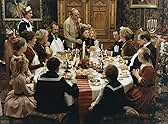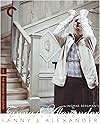NOTE IMDb
7,5/10
1,1 k
MA NOTE
Ajouter une intrigue dans votre langueA chronicle of the making of Ingmar Bergman's Oscar winning film.A chronicle of the making of Ingmar Bergman's Oscar winning film.A chronicle of the making of Ingmar Bergman's Oscar winning film.
- Réalisation
- Scénario
- Casting principal
Avis à la une
While the making of Ingmar Bergman's last film, Fanny and Alexander, has been available on video for some time, that it is now available along-side the new American DVD release of the TV series/Theatrical cuts makes it essential viewing. Along with an interview as a bonus feature with Bergman in 1984, the film acts like a kind of sequel to another director's documentary- "Ingmar Bergman Makes a Movie"- which charted his production of Winter Light.
For Fanny and Alexander, we as the audience get an evolutionary look at the production, from out-door scenes simply involving a horse and carriage, to the elaborate, joyous Christmas and Christening dinners, and to the dead silent, dead serious scenes involving the tragedies in the story. The inter-titles put in by Bergman himself in-between the segments is another unexpected treat- as he comments on what's going on with the actors and the set-ups, there is a little humor here and there (i.e. a reference to a high church official who got upset about an incident involving a TV antenna).
And like with the previous documentary on Winter Light, Document of Fanny and Alexander provides for Bergman and non-Bergman fans alike to see what goes into the directorial/shooting process. How does a director talk to the actors? How does the director of photography (as with the previous film, the master Sven Nykvist) fit into shaping the scenes? And is the mood always completely focused, or does a shot of excitement over the process get over them (in other words, what's the mood)?
These kinds of questions are answered with an unflinching eye for the viewer, and at worst can only make the filming process to be boring (which it can be). But for a behind-the-scenes venture, there's a lot worse out there.
For Fanny and Alexander, we as the audience get an evolutionary look at the production, from out-door scenes simply involving a horse and carriage, to the elaborate, joyous Christmas and Christening dinners, and to the dead silent, dead serious scenes involving the tragedies in the story. The inter-titles put in by Bergman himself in-between the segments is another unexpected treat- as he comments on what's going on with the actors and the set-ups, there is a little humor here and there (i.e. a reference to a high church official who got upset about an incident involving a TV antenna).
And like with the previous documentary on Winter Light, Document of Fanny and Alexander provides for Bergman and non-Bergman fans alike to see what goes into the directorial/shooting process. How does a director talk to the actors? How does the director of photography (as with the previous film, the master Sven Nykvist) fit into shaping the scenes? And is the mood always completely focused, or does a shot of excitement over the process get over them (in other words, what's the mood)?
These kinds of questions are answered with an unflinching eye for the viewer, and at worst can only make the filming process to be boring (which it can be). But for a behind-the-scenes venture, there's a lot worse out there.
10iF....
This is a documentary to see if you are interested in how movies are made. Seeing the master filmmaker Ingmar Bergman direct his last movie was so sentimental yet sad. During certain scenes he was directing, you could see REAL drama in the actor's faces whenever they tried their best to impress Bergman. You could see a sense of humanity and the close relationship between the people on set. See this film, you won't be disappointed.
The next best thing to watching Bergman's films is for me to watch and listen to him talking about himself and about his works. "Making of" is a fascinating document - I always wanted to know how he makes his films, what is behind the poetry of images and the sound of silence. Following the master's steps, watching the most magical scenes born in front of you, seeing him in control of his production, always knowing what he wants and leading his crew and his actors; his longtime friendship with his legendary cinematographer Swen Nykwist to the point that they don't talk much - they don't need many words to understand each other - all of these made "Making of Fanny and Alexander" absolutely unique and amazing experience for me. The birth of each scene is a miracle but some of them stand out. The first is one of the most enigmatic and magical scenes ever and not only in Bergman's films - night scene in the Isak's house between Alexander and Ismael, a completely mysterious character with supernatural psychic powers who helped Alexander to unleash his own powers he never knew he had.
The second is the scene with Gunnar Björnstrand, one of the most versatile Bergman's actors (Höstsonaten, (1978), Ansikte mot ansikte (1976), Skammen (1968), Persona (1966), Nattvardsgästerna (1963), Såsom i en spegel (1961), Ansiktet (1958), Smultronstället (1957), Sommarnattens leende (1955), and his masterpiece Det Sjunde inseglet, (1957)). He was old and apparently ill while making Fanny and Alexander which was his last film. The scene in "Making of..." is almost 20 minutes long and shows over and over how Bergman rehearses a short, perhaps one or two minute long cameo with Björnstrand as clown Feste in Shakespeare's "Twelfth Night". It is painful to watch a great actor in such a pitiful state. At some point you'd want Bergman to stop what seems like a torture but he goes on, encouraging his friend, praising him, making sure that Gunnar feels comfortable but not stopping before the scene is shot to his liking...
The second is the scene with Gunnar Björnstrand, one of the most versatile Bergman's actors (Höstsonaten, (1978), Ansikte mot ansikte (1976), Skammen (1968), Persona (1966), Nattvardsgästerna (1963), Såsom i en spegel (1961), Ansiktet (1958), Smultronstället (1957), Sommarnattens leende (1955), and his masterpiece Det Sjunde inseglet, (1957)). He was old and apparently ill while making Fanny and Alexander which was his last film. The scene in "Making of..." is almost 20 minutes long and shows over and over how Bergman rehearses a short, perhaps one or two minute long cameo with Björnstrand as clown Feste in Shakespeare's "Twelfth Night". It is painful to watch a great actor in such a pitiful state. At some point you'd want Bergman to stop what seems like a torture but he goes on, encouraging his friend, praising him, making sure that Gunnar feels comfortable but not stopping before the scene is shot to his liking...
While I can see the interest in seeing Ingmar Bergman and Sven Nyqvist behind the camera and at work, there has to be a little more to it than having a second cinematographer run a camera on the crew to make two films (the film and this doc) at once for the price of one. Dokument Fanny och Alexander provides bits and pieces of interesting, valuable material, but is lacking in many respects. It focuses on Bergman and Nyvqist behind the camera, but provides very little insight into the genesis of the story, its meanings, or any of the other crew: nothing on Asp's vision or Vos' work, nothing from the cast about how they approached their work. The doc A Bergman Tapestry, also included in Criterion's Blu-ray, is more valuable and well-rounded in that regard.
As for what we see, it doesn't take long for things to get repetitive. Did we really have to see that clown with the candle on his head *that* many times?
As for what we see, it doesn't take long for things to get repetitive. Did we really have to see that clown with the candle on his head *that* many times?
Aspiring directors -- even if it's only family movies with a camcorder they plan to make -- should see this documentary on how the master film maker created magic. Bergman knew what he wanted before he planned each scene. So have many other directors. And some of the actors who worked with some of these other directors never made another film again. Bergman got his favorite actors to come back film after film, because he knew how to get them to do takes over and over again without destroying their egos. His work with the two children is especially touching. "My sister and I giggled like that," he told the youngsters playing Fanny and Alexander.
Le saviez-vous
- AnecdotesThis film is part of the Criterion Collection, spine #264.
- ConnexionsEdited from Fanny et Alexandre (1982)
Meilleurs choix
Connectez-vous pour évaluer et suivre la liste de favoris afin de recevoir des recommandations personnalisées
Détails
Contribuer à cette page
Suggérer une modification ou ajouter du contenu manquant























